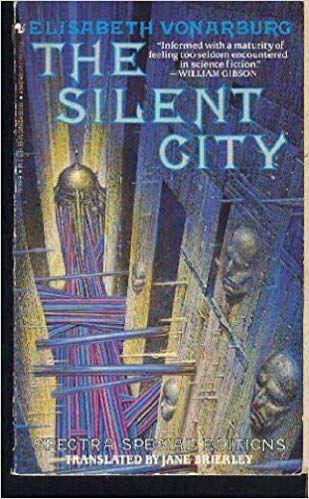 translated from the French by Jane Brierley
translated from the French by Jane Brierley
Press Porcépic
1988
261 pages
I read In the Mothers’ Land before I read The Silent City, and this switch in the order made for an intriguing and wonderful experience. While with some series, you won’t understand what’s going on unless you read the books in order; and with others, the stories are generally related but don’t rely on one another in terms of plot points; Vonarburg’s Silent City series falls somewhere in the middle of those two poles. While the novels are indeed connected, they’re set centuries apart, such that the people and events in The Silent City have become legends in Mothers’ Land.
Thus, Vonarburg isn’t just telling us the story of a people as they develop their civilization over time; she’s also, and more importantly, asking us to consider the ways in which facts, events, and individuals turn into stories, legends, and religious symbols. On yet another, and for me even more fascinating level, Vonarburg imagines that the religious matriarchal communities of Mothers’ Land (mirroring our own ancient history) have developed after and because of a technologically-advanced human civilization that had evolved underground after global catastrophe had devastated the surface and knocked the remaining humans back to a kind of “stone age.”
Both novels are bildungsromans, focusing on the lives and experiences of their respective female protagonists. We follow Lisbeï as she comes of age in Mothers’ Land, learning about the matriarchal structure of her society and the religious and biological reasons for that structure; while Elisa grows and develops in the underground City, nurtured and surrounded by robotic surrogates (some of whom are controlled by very old humans who are kept alive in another chamber; the others are not connected to humans). Elisa’s journey to the surface mirrors her psychological journey from childhood to adulthood: first she must understand that most of the people raising her are not “fully” human, and then she needs to decide how to move forward (stay in the City or go Outside with a new race of humans that she can create in the City’s laboratory?).
Her choice to use the resources of the City to raise several generations of children (with the help of many robot surrogates) and then take them Outside leads to her encounter with a community of people that scavenge from the ruins of the previous civilization. There, Elisa learns about a group of women that have thrown off the yoke of slavery and servitude and formed their own neighboring community. Women far outnumber men on the Outside, thanks to a mysterious virus that has developed over the centuries. Meanwhile, Elisa’s children are not only able to recover quickly from injuries (like she can) but are also able to switch genders at will (Elisa can only do it with the help of meditation). The shock to the Outsiders of Elisa and her children’s seemingly god-like powers leads the former to believe that the City people are divine. It’s here that we can see the beginnings of what would eventually become the religion of Mothers’ Land: Elli/Elisa as God and her campagnas/comrades as Christ-like and disciple figures.
The Silent City uses the post-apocalypse theme to explore questions of self-identity, gender, the biological/artificial, and the development of organized religions. Taken together, The Silent City and In the Mothers’ Land tell a beautiful, complex story that will leave you wishing for that third novel.
